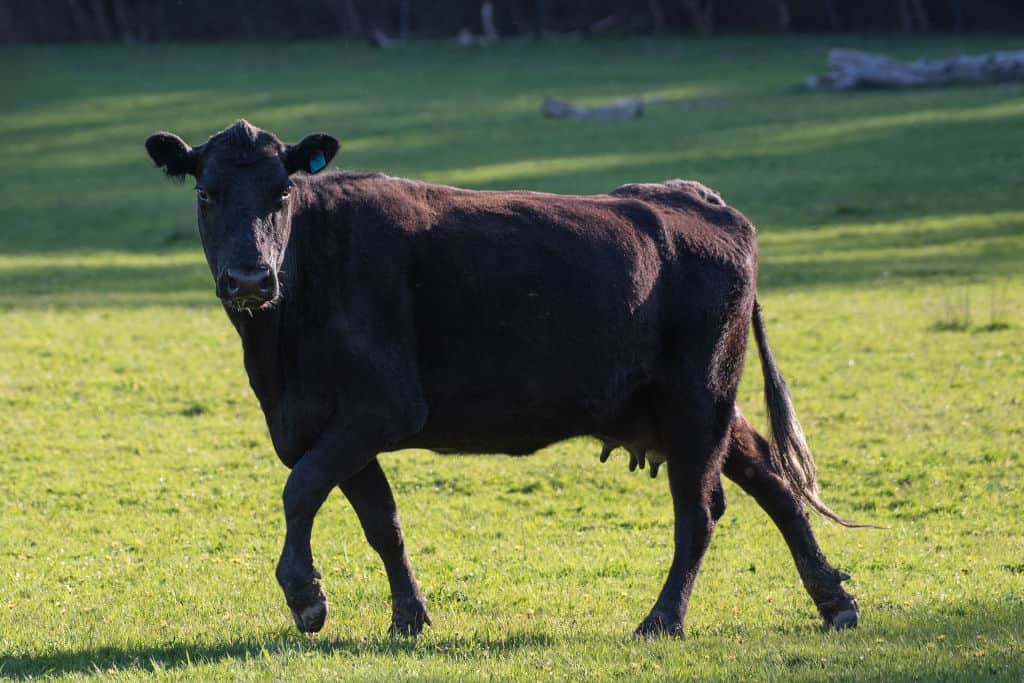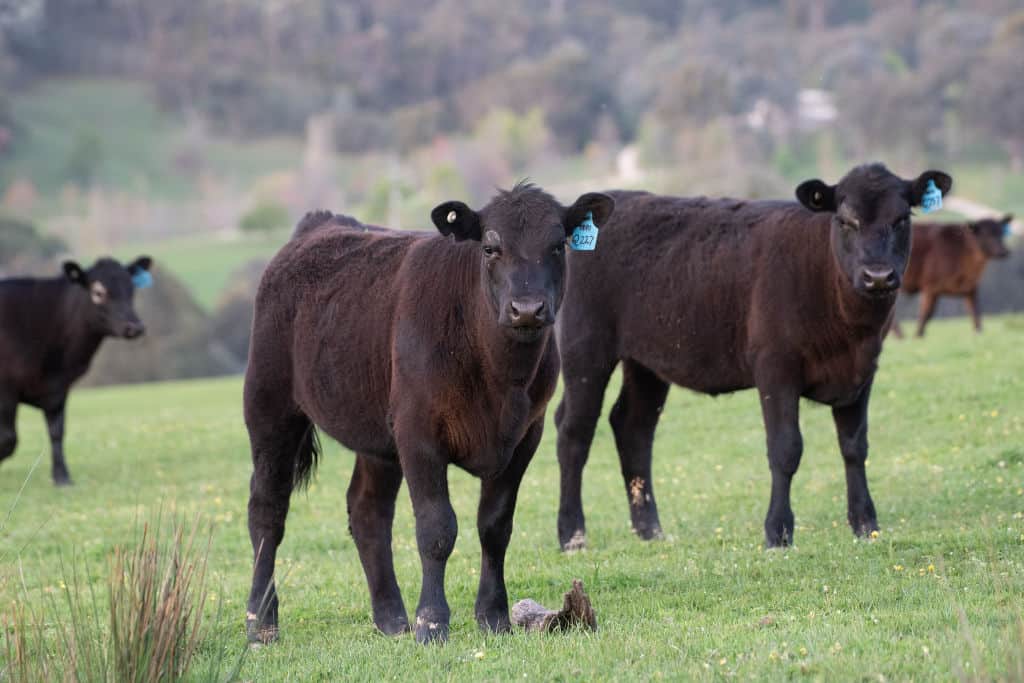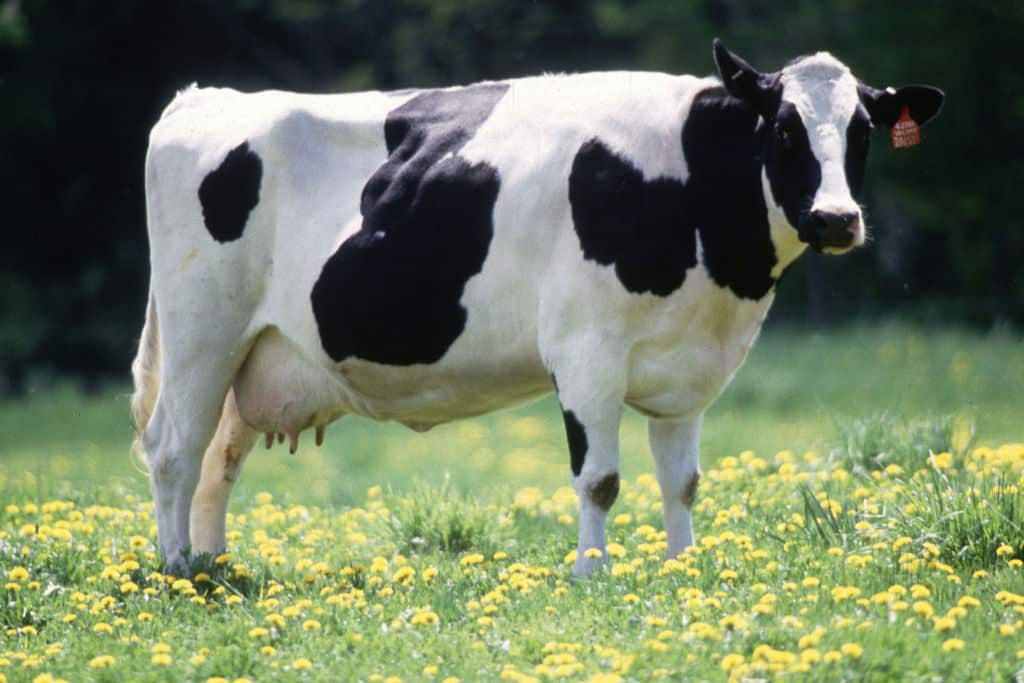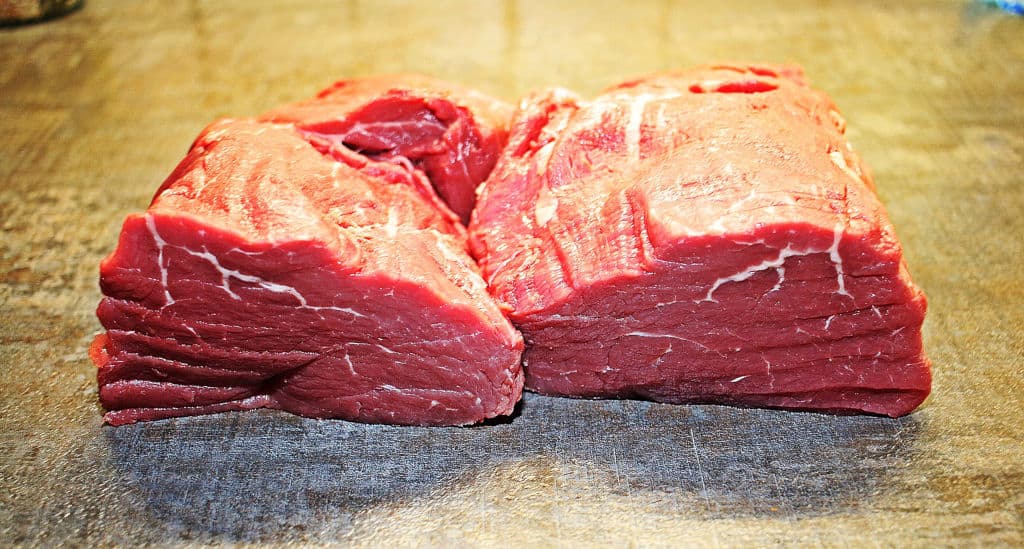Hiw Much Do Beef Cattle Weigh at Birth Natural Milk Production of Dairy Cows
Cows greatly vary in weight depending mostly on the breed and the age of the cow.
According to North Dakota State University data, the weight ranges greatly for a typical herd. There's no one average number for all the breeds combined, but… For now, let's try to answer the general question about the average weight of a cow.
How Much Does a Cow Weigh? In the US, the average weight of a mature beef cow (such as Angus) is about 1,210 pounds, while the average weight of an adult dairy cow (such as Holstein) is around 1500 pounds. However, a cow's weight will greatly vary by breed.
For example, Holstein dairy cows are one of the larger ones, and usually weigh about 1,500 pounds fully grown, while Jersey dairy cows are on the smaller side, weighing about 900 pounds on average, when full-grown.
We can separate the weights relative to the age and the breed of the cow, as shown below.
If you're looking to get into the beef productions business then it's important to have the right equipment, such as feed bunks, hay feeders (portable even better), headgate, holding chute, working chute, and a few other important items.
Let's look at the cow's weight more precisely.
How Much Does a Cow Weigh?
Beef cattle (raised for meat production primarily) and dairy cattle (raised for milk primarily) typically weigh differently, but even among the beef or dairy breeds, we have huge differences.
I've used data from research and calculations on The Pennsylvania State University, North Dakota State University, and Wikipedia itself to get the most accurate and recent data about cow weights (by age and by gender).

I've used this data to put together tables of weights for heifers (female calves) by month, and some data on the major breeds in the US and their average weights.
Herders always weigh a cow at weaning, which is the time when a calf is separated from the mother. Ideally, this is at 7-8 months old. Cows continue gaining weight until they reach 7 years of age, then they slowly lose weight until they leave the herd.
The weight of a cow depends mostly on these factors:
- age
- breed
- location
- nutritional history
- individual traits
This means the weights can range wildly, but, we can still take the averages to be useful, based on the large available data set.
These averages should be helpful, or at least, interesting to ponder about.
For more information on the breeds of beef cattle, visit the Oklahoma State Beef Breeds Directory.

How Much Does a Beef Cow Weigh?
A typical beef cow such as Angus weighs around 1210 lbs (550kb) for a mature female, and around 1870 lbs (850 kg) for bulls (on average). For a typical herd, this is not a very useful answer because the herd may consist of a variety of cows by age and breed.
Cow weight will greatly vary based on many factors.
Angus beef cow will be about 450-550 pounds when 6 months old, while a mature heifer could weigh anywhere between 800 and 1400 pounds. Heifer growth is usually compared to breed standards to determine normal progress.
Here is a list of the average weight of beef cows by breed (female):
- Angus – 1,210 pounds (550 kg)
- Hereford – 1,200 pounds (544 kg)
- Limousin – 1,650 pounds (750 kg)
- Brahman – 1,320 pounds (600 kg)
- Simmental – 1,300 pounds (590 kg)
- Shorthorn – 1,760 pounds (800 kg)
Sources: 1, 2, 3, 4, 5, 6
Males (bulls) are naturally a lot heavier.
The average weight of male beef cows by breed (bulls):
- Angus – 1,870 pounds (850 kg)
- Hereford – 1,800 pounds (816 kg)
- Limousin – 2,530 pounds (1150 kg)
- Brahman – 2,100 pounds (950 kg)
- Simmental – 2,500 pounds (1134 kg)
- Shorthorn – 2,100 pounds (950 kg)
If you are looking to get into the beef production business (or are there already) then the general answer to a general question is not that useful for you.
What's more important is the weight of cows you are turning out to pasture.
In an ideal world, you'd want to hit 1150 lbs in 15-16 months for a typical beef cow, but this would depend a lot on genetics and breed, and is difficult to reach.
How much do cows weigh in a typical herd?
At NDSU Dickinson Research Extension Center, they monitor cow weight throughout the years, and here is the data from a few years ago on the weights of cows in the herd:

This herd was a combination of Angus, Red Angus, and Hereford breeding, with the lighter-weight cows showing the influence of Lowline breeding.
Knowing the weight of the cows being turned out to grass is something every producer needs to know, and it is a cornerstone for good management.
How Much Does a Dairy Cow Weigh?
Depending on the breed, a full mature Holstein dairy cow weighs around 1,500 lbs (700 kg) on average, a mature Ayrshire weighs around 990 to 1,320 lbs, while the Jersey breed (being among the smallest of the dairy breeds) weighs around 900 lbs (410kg) on average.
These are all (naturally) female cow weight examples, while the males usually weigh more.

Here is a list of the average weights of dairy cows by breed – female:
- Holstein-Friesian – 1,600 pounds (725 kg)
- Ayrshire – 1,150 pounds (522 kg)
- Jersey – 900 pounds (408 kg)
- Brown Swiss – 1,350 pounds (612 kg)
- Guernsey – 1,050 pounds (476 kg)
- Dairy Shorthorn – 1,450 pounds (658 kg)
Sources: 1, 2, 3, 4, 5, 6
As you can see, there is no one single answer to a weight of an average dairy cow across all breeds.
How Much Does a Calf Weigh?
A calf is a young domestic cattle, and its weight quickly grows every month.
The calf at birth will weigh about 82 pounds. A commercial steer (bull calf) is expected to put on about 71 to 79 lbs (32-36kg) per month, while a heifer puts on less, depending on the breed.
I've looked more closely into dairy cow heifer weights by age, and got the data from PennState Uni on heifer growth and the average and recommended weights of the most popular dairy cow breeds in the US.
Average Calf Weights by age (Holstein, Jersey, Brown Swiss)
| Age | Holstein (weight in lbs) | Jersey (weight in lbs) | Brown Swiss (weight in lbs) |
|---|---|---|---|
| 1 month | 119-136 | 93-108 | 134-163 |
| 2 months | 161-189 | 122-146 | 187-223 |
| 3 months | 211-234 | 155-177 | 240-283 |
| 4 months | 258-284 | 183-217 | 293-343 |
| 5 months | 311-339 | 233-278 | 345-403 |
| 6 months | 369-422 | 259-321 | 396-462 |
| 8 months | 468-530 | 335-412 | 498-580 |
| 10 months | 575-653 | 391-483 | 597-694 |
| 12 months | 682-760 | 471-548 | 693-805 |
| 14 months | 776-878 | 535-602 | 785-912 |
| 18 months | 969-1066 | 639-753 | 955-1107 |
| 24 months | 1170-1301 | 790-893 | 1167-1343 |
Average Calf Weights by age (Guernsey, Ayrshire, Milking Shorthorn)
| Age | Guernsey (weight in lbs) | Ayrshire (weight in lbs) | Milking Shorthorn (weight in lbs) |
|---|---|---|---|
| 1 month | 122-143 | 131-154 | 128-160 |
| 2 months | 166-193 | 177-205 | 175-210 |
| 3 months | 203-233 | 223-256 | 223-262 |
| 4 months | 255-299 | 269-307 | 272-315 |
| 5 months | 299-354 | 315-357 | 320-370 |
| 6 months | 366-434 | 360-407 | 369-425 |
| 8 months | 433-503 | 450-506 | 467-539 |
| 10 months | 511-588 | 538-602 | 564-653 |
| 12 months | 576-674 | 624-697 | 658-765 |
| 14 months | 696-803 | 707-789 | 750-874 |
| 18 months | 864-1001 | 864-965 | 920-1071 |
| 24 months | 1026-1178 | 1070-1206 | 1128-1281 |
Source: PennState Extension at The Pennsylvania State University
Ranges for Holstein are between 50th and 75th percentile – the first number is 50th and the second is 75th percentile. Recommended ranges are above 75th percentile (2nd number). Percentiles describe the percentage of observations that fall below that level. Recommended ranges for other breeds (not Holstein) represent the 50th to 67th percentile.
For more info visit the PennState website.
Data is from measuring a large number of heifers of various breeds throughout the United States during 1991 and 1992. Calculations are done by PennState Extension at the College of Agricultural Sciences, The Pennsylvania State University, and updated in 2017.
How Much Does a Cow Weigh When Butchered?
For commercial productions, cows weigh usually 900 to 1,350 pounds at slaughter. The average cattle weight at slaughter will depend on customer demands, which determine the age range and weight of cattle.
Source: Dickinson Research Extension Center data on herds.
For example, Angus beef cattle weigh around 1,200 pounds at slaughter, with a carcass weight of 750 pounds (hanging weight, "on the rail").
However, cattle have variations in body size, and customer demands are always different. Some want meat from younger cows, as it is generally more tender, and some want veal meat, which is meat from a calf that is 6 months or younger.
Average cow weight at slaughter can therefore be on any point of the spectrum of this range of weights.
The carcass size is relevant because it is a driver of income.
If you're looking to get into the beef production business, the sole source of your income will come from calves produced each year, which is why it is important that your cows produce a calf at least every 12 months.
Another important thing is to decide what kind of operation you're going to run. Some of the typical ones are:
- cow/calf
- backgrounding feeder calves
- feedlot
Whatever you choose, there are plenty of resources out there that will help you run your business successfully. You can start at PennState Extension beef production guidelines.

How Much Meat Do You Get From a Cow?
According to South Dakota State University Extension , the expected yield for retail cuts from beef carcasses ranges from 55% to 75%, depending on the fatness, muscling of the animal, and the type of cuts you produce. The carcass weight is usually between 600 and 900 pounds.
Steaks usually come from a steer (castrated male) or a heifer (female that hasn't been bred), while meat from cows is usually ground up into processed meats.
The US beef industry is focused mostly on producing steers for meat consumption.
Dairy cows are better utilized in producing milk, and because of their inability to dress out nicely (give large quantities of quality meat), the cow is graded low by the USDA and normally goes to auction and slaughter for processed meat.
One of the most popular cattle breeds, Angus, has been used for a long time because it gives lots of prime grade meat, good marbling, etc.
How much meat do you get from a cow?
Let's take an example.
If you start with a 1,200 steer (a castrated male), which has a typical dressing of 63%, that's about 750 pound carcass. From that, you will get about 65% of carcass weight (on average), which is about 490 pounds of trimmed beef.
If we calculate that against live weight, you get an average of 40% of live weight, fatness being around 12% of live weight.
The amount of meat you get from cattle varies, and this is just an approximation.
How much meat will a cow yield depends on the breed, age, and diet.
How Many Steaks in a Cow?
Once again, for those unfamiliar, steaks generally come from steer (male cows) while the meat from female cows is generally ground up and considered lower grade.
Let's take a look at two examples and the amount of meat you can get.
Example 1)
If we use the example above for a 1,200 pounds steer, from SDSU Extension, and cut the carcass into primarily boneless steaks and roasts, we would get (on average):
- 90 pounds of boneless chuck roasts and steaks (10-12% of carcass weight)
- 85 pounds of round roasts and steaks (10-12% of carcass weight)
- 80 pounds of rib and loin steaks (10-12% of carcass weight)
- 50 pounds of other cuts (brisket, flank, short ribs, skirt steak)
- and 185 pounds of lean trim, or ground beef (20-25% of carcass weight)
For individual types of steak, you would get:
- 18 pounds of strip loin steaks (2.5%),
- 9 pounds of tenderloin steaks or filets (2.5%),
- in general, less than 3% per individual type of steak
Example 2)
Another example of 1,000 lb. as shown by the Oklahoma Department of Agriculture Food and Forestry gives similar results.
Their average hanging weight, also called "on the rail" is 61%, for a 1,000 pounds steer, which is 610 lbs of beef. Further weight loss for meat accounts for 18%, which leaves you with 430 pounds of meat that would go into retail cuts (steaks, roasts, ground beef, etc.)
Here are the amount of retail cuts you would get:
- Round (round steak, rump roast, sirloin tip steak, etc.) – 103.2 lbs
- Sirloin (sirloin steak, stew and ground beef) – 38.7 lbs
- short loin (porterhouse steak, T-bone steak) – 34.4 lbs
- flank (flank steak, short ribs) – 17.2 lbs
- rib (rib eye steak, rib steaks, back ribs) – 38.7 lbs
- short plate (skirt steak, short ribs) – 30.1 lbs
- chuck (chuck roast or steak, arm roast) – 107.5 lbs
- brisket – 25.8 lbs
- shank – 17.2 lbs
- suet & hanging tender – 17.2 lbs
These are just the averages, and the actual live weight to retail cuts yield varies, depending on breed, fat to muscle ratio, age, cutting order, etc.
Largest Cows in the World
The heaviest breed of a cow in the world is Chianina, which can weigh up to 3,500 pounds when mature, or 1500kg.
It is one of the oldest cattle breeds in the world and its use is dual-purpose: both for meat and draught use (working animal). Chianina cows have very little milk to produce, barely sufficient for suckling.
The second largest is probably South Devon, which is the largest of the British native breeds.
Smallest Cows in the World
The smallest breed of cows in the world is the Dexter miniature cow, which weighs only 600 to 700 pounds for mature bulls, or 272 to 318 kg.
The Dexter breed originated in Ireland, then was brought to UK and US. It then eventually disappeared from Ireland but was still maintained as a pure breed in several small herds in England and the US.
Dexter cows are friendly, dual-purpose breed, used for milk and beef, but often also used for oxen, which is an animal used for plowing, transport, threshing grain by trampling and powering machines that grind grain or supply irrigation.
Their versatility is one of their greatest assets, and they also produce rich milk high in butterfat.
Source: https://howmonk.com/how-much-does-a-cow-weigh/
0 Response to "Hiw Much Do Beef Cattle Weigh at Birth Natural Milk Production of Dairy Cows"
Post a Comment